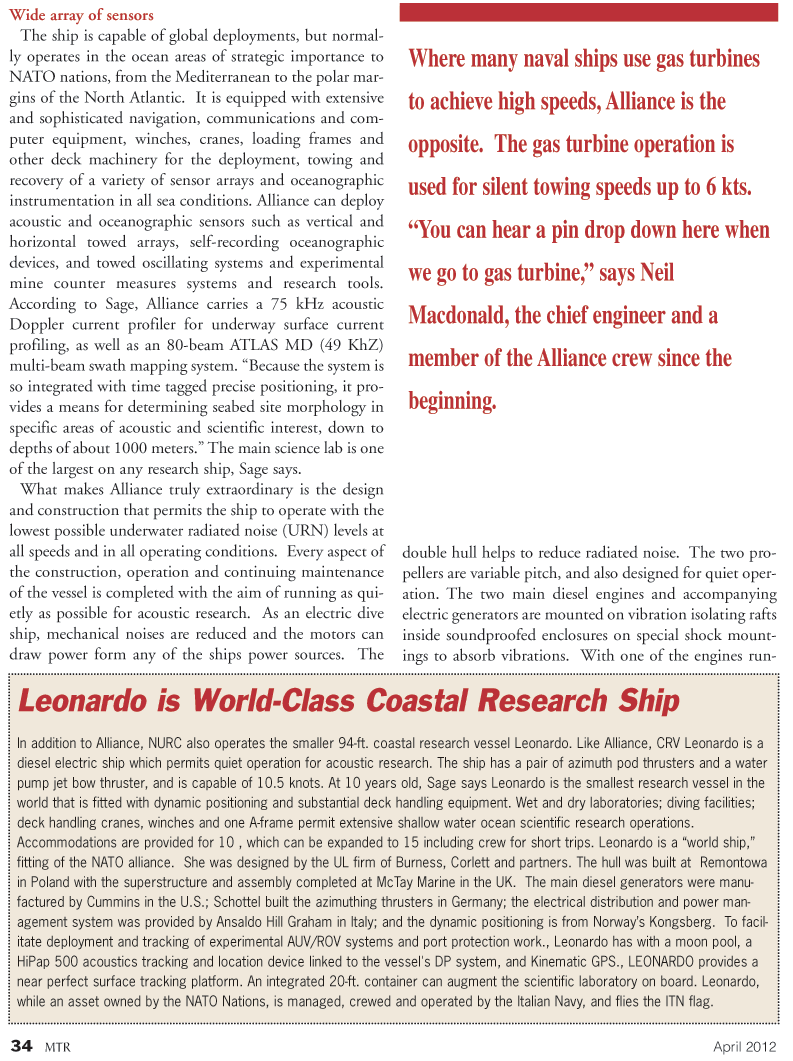
Page 34: of Marine Technology Magazine (April 2012)
Global Offshore Deepwater Report
Read this page in Pdf, Flash or Html5 edition of April 2012 Marine Technology Magazine
34MTRApril 2012Wide array of sensors The ship is capable of global deployments, but normal- ly operates in the ocean areas of strategic importance to NATO nations, from the Mediterranean to the polar mar- gins of the North Atlantic. It is equipped with extensive and sophisticated navigation, communications and com-puter equipment, winches, cranes, loading frames andother deck machinery for the deployment, towing and recovery of a variety of sensor arrays and oceanographic instrumentation in all sea conditions. Alliance can deploy acoustic and oceanographic sensors such as vertical and horizontal towed arrays, self-recording oceanographic devices, and towed oscillating systems and experimental mine counter measures systems and research tools. According to Sage, Alliance carries a 75 kHz acoustic Doppler current profiler for underway surface current profiling, as well as an 80-beam ATLAS MD (49 KhZ) multi-beam swath mapping system. Because the system is so integrated with time tagged precise positioning, it pro- vides a means for determining seabed site morphology inspecific areas of acoustic and scientific interest, down to depths of about 1000 meters.? The main science lab is one of the largest on any research ship, Sage says. What makes Alliance truly extraordinary is the design and construction that permits the ship to operate with the lowest possible underwater radiated noise (URN) levels at all speeds and in all operating conditions. Every aspect of the construction, operation and continuing maintenance of the vessel is completed with the aim of running as qui- etly as possible for acoustic research. As an electric dive ship, mechanical noises are reduced and the motors can draw power form any of the ships power sources. The double hull helps to reduce radiated noise. The two pro- pellers are variable pitch, and also designed for quiet oper- ation. The two main diesel engines and accompanying electric generators are mounted on vibration isolating rafts inside soundproofed enclosures on special shock mount- ings to absorb vibrations. With one of the engines run- Leonardo is World-Class Coastal Research ShipIn addition to Alliance, NURC also operates the smaller 94-ft. coastal research vessel Leonardo. Like Alliance, CRV Leonardo is adiesel electric ship which permits quiet operation for acoustic research. The ship has a pair of azimuth pod thrusters and a wa terpump jet bow thruster, and is capable of 10.5 knots. At 10 years old, Sage says Leonardo is the smallest research vessel in the world that is fitted with dynamic positioning and substantial deck handling equipment. Wet and dry laboratories; diving facilit ies;deck handling cranes, winches and one A-frame permit extensive shallow water ocean scientific research operations. Accommodations are provided for 10 , which can be expanded to 15 including crew for short trips. Leonardo is a world ship,? fitting of the NATO alliance. She was designed by the UL firm of Burness, Corlett and partners. The hull was built at Remonto wain Poland with the superstructure and assembly completed at McTay Marine in the UK. The main diesel generators were manu- factured by Cummins in the U.S.; Schottel built the azimuthing thrusters in Germany; the electrical distribution and power man- agement system was provided by Ansaldo Hill Graham in Italy; and the dynamic positioning is from Norways Kongsberg. To facil- itate deployment and tracking of experimental AUV/ROV systems and port protection work., Leonardo has with a moon pool, a HiPap 500 acoustics tracking and location device linked to the vessel's DP system, and Kinematic GPS., LEONARDO provides a near perfect surface tracking platform. An integrated 20-ft. container can augment the scientific laboratory on board. Leonardo ,while an asset owned by the NATO Nations, is managed, crewed and operated by the Italian Navy, and flies the ITN flag. Where many naval ships use gas turbines to achieve high speeds, Alliance is the opposite. The gas turbine operation is used for silent towing speeds up to 6 kts. You can hear a pin drop down here when we go to gas turbine,? says Neil Macdonald, the chief engineer and amember of the Alliance crew since the beginning.

 33
33

 35
35
